It is natural that a personwould concern himself with food whenever arriving at astrange place.A satisfactory meal can brighten anyone’s travel. This is particularly true when people go to Xinjiang.
The vast grasslands in Xinjiang breed millions of cattle,sheep andhorses,and produce plenty of fresh milk.The oases yield an abundanceof wheat,corn and fruits,as well as various kinds of vegetables,suchas, carrots,potatoes,onions and fennel.These local products dictatethat Xinjiang cuisine is mainly about meat and pasta.Beef and mutton are the two major kinds of meat used in Xinjiangcuisine,and they are usually prepared in very simple ways-water-boiled or shallow-fried-to preserve their original meaty tastes. And flour is traditional staple food of the Xinjiang people.There are manifestations:“lamian”(pulled-noodle),“ganmian"(rolling-noodle),"“naren",“baked nang”,“cold noodles"“baoershake”(a fried snack)and a type of Russian-style bread.Famous dishes made of pasta are also include“latiaozi”,“youtazi”,"liangpizi”,“michangzi”,“mianfeizi”and “thin-crust stuffed buns".
Xinjiang people are very practical about their food, for them, the taste is more important than appearance.The “pilaf”or“shouzhuafan -mutton with rice that you eat with your fingers",has been popularfor nearly thousands of years.The plain-looking“Lagman",or“Banmian-seasoned noodles”,never gets old. And there is the “Dapanji",or“spicy big plate chicken” served on a huge plate’,one of the best known Xinjiang dishes ThroughoutChina.According to ancient books, kebab has a history of more than 1800 years in China. Xinjiang roast mutton kebab is famous for its unique flavor, hot and fat flavor.
Kebab
Kebab is one of the most famous ethnic cuisines in Xinjiang. Kebabs are made by roasting and moxibustion on a special iron pot for barbecue. The iron trough is divided into two layers, the middle partition plate is porous, and anthracite is used as fuel. The iron chisel used to bake mutton kebabs is 30cm long and has a wooden handle at one end. When making mutton kebabs, first cut the refined mutton into 3 square centimeter thin slices, put on the iron chisel in turn, and then put it on the barbecue tank. At the same time, bake it with coal fire, sprinkle the seasoning such as refined salt, chili powder, cumin powder, etc. at the same time, turn over the other side for 3-5 minutes or so, and then eat it in a few minutes.Xinjiang barbecue is very characteristic.When a distinguished guestcomes visiting, locals usually roast a lamb as a greeting food. Shish Kebab area decent,economic choice of food for friendsreunion.
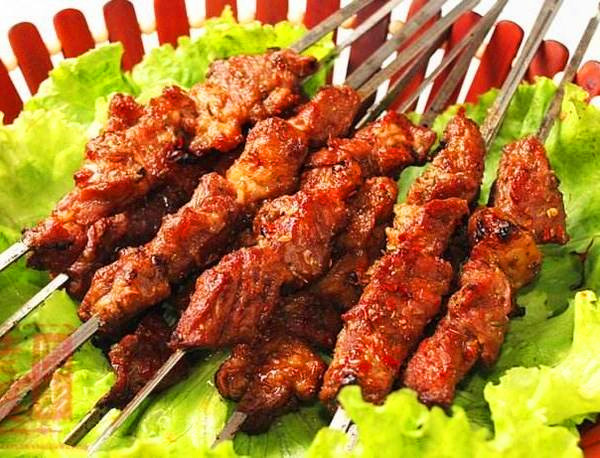
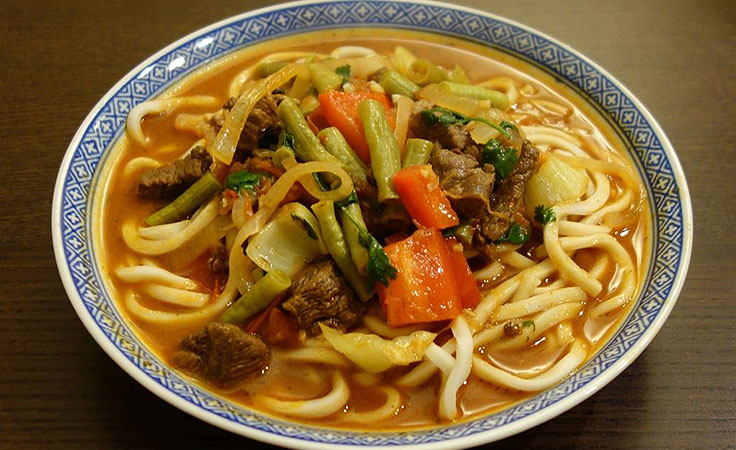
Tasty Laghman
Xinjiang mixed noodles, as a kind of pasta, has a long history, which is cooked first and then stir fried,From the perspective of scientific diet, Xinjiang Laghman is a kind of food with the combination of vegetables and noodles. It is mainly composed of pasta, supplemented by vegetables. The dishes can be meat or vegetable, and the taste can also be determined according to the taste of the guests. There are also various kinds of mixed noodles: mutton, egg, pickled vegetable, fried meat, ground meat, beef, chicken, potato and so on.This food is very suitable for northern people’s eating habits. In Xinjiang, it is a kind of delicious food that everyone can make and enjoy.
Pilaf
Grabbing rice is a Chinese name.,It’s called Polo in Uyghur. It means rice stewed with (beef) mutton, rice, radish and vegetable oil. It’s called grabbing rice because it’s eaten by hand.Grabbing rice is one of the favorite foods of people of all ethnic groups in Xinjiang. Pilaf is very nutritious,so they called Pilaf or Polo is a king of Xinjiang food, and can make your body very strong ,and the yellow radish is the core of rice grabbing. It is commonly known as “Xinjiang ginseng". It has the functions of Invigorating Qi, promoting blood circulation, promoting body fluid, relieving thirst, calming nerves and improving intelligence it also a essential meal for every guests we invite to our home. It’s not compulsory to eat“zhuafan"with your hands.Eat with a wooden scoopstill tastes yummy.
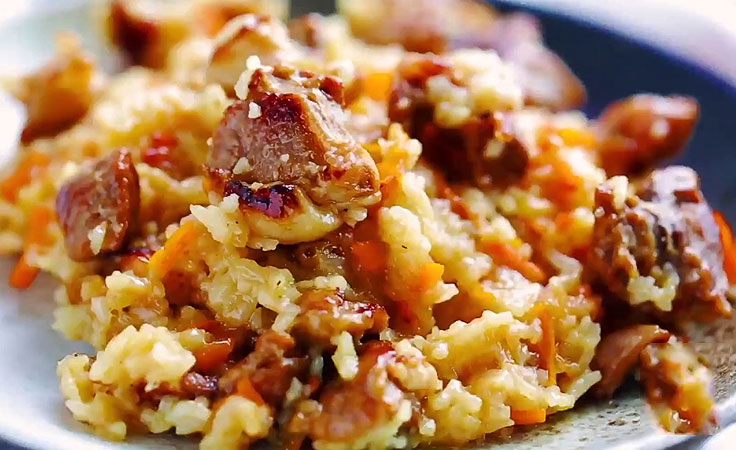
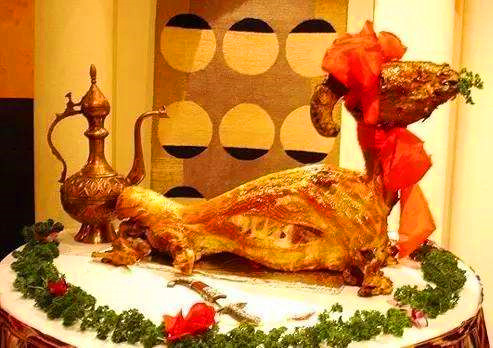
Whole Lamb Kabap
The Uyghur name of roasted whole sheep is “tunur kawafu", which is one of the most distinctive traditional flavors in Xinjiang. The exterior of the sheep is golden and shiny, the exterior meat is burnt yellow and crisp, the interior meat is soft and tender, and the mutton is delicious. The traditional way to roast the whole sheep in Xinjiang is to kill and peel the sheep, remove the head, hoof and internal organs, then use an iron bar to string the sheep from the neck to the tail, then mix it with egg yolk, saltwater, turmeric, cumin powder, pepper, flour, etc. to paste it on the whole body of the sheep, and then put the sheep head down into the blazing Nang pit, cover the pit mouth tightly, and bake it for about 1.5 hours. In general, the restaurant ties a red colored silk on the roasted sheep’s head, and puts some parsley and celery in the mouth of the sheep, so that the whole sheep becomes a delightful work of art.
Samsa
Samsa(baked bun) is one of the famous cuisines of Uygur nationality. It’s named because its filling is baked in Nang pit. From the perspective of scientific diet, when lamb and onion are used as stuffing, their nutritional components can be complementary. Onion, known as the queen of dishes, has the functions of dispelling wind, sweating, detoxification and swelling, in addition to rich vitamins and sugars. It is especially worth mentioning that onion has the functions of dissolving thrombus and expanding blood vessels. Therefore, the Uygur people who often eat baked bun get thrombus disease Less sick
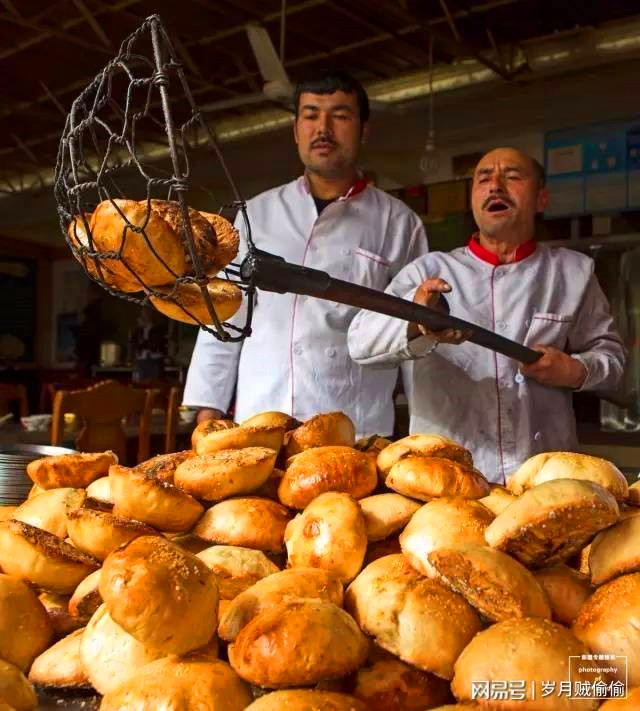
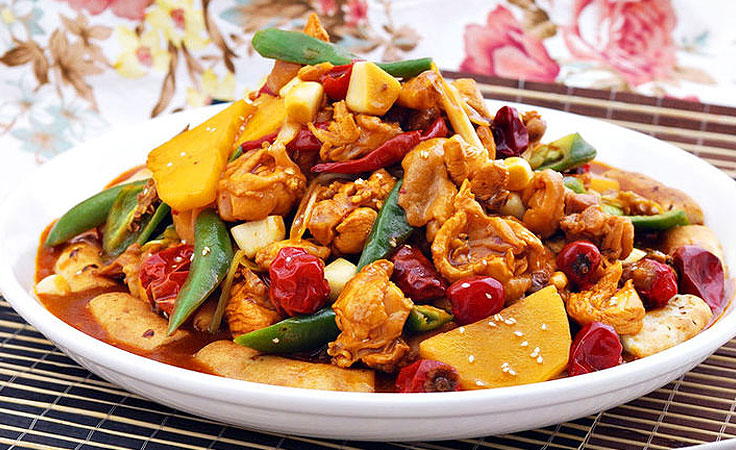
Dapanji
Xinjiang Dapan chicken, also known as Shawan Dapan chicken, is a famous dish in Xinjiang. And it is one of the top ten classic dishes in Xinjiang.It originated in the 1980s. It is mainly made of chicken pieces and potato pieces and cooked with belt noodles Its colorful, smooth and spicy chicken and soft, waxy and sweet potatoes, spicy with fragrance, thick with fine, are the best on the table.
This dish, with unique taste and novel taste, not only has the rough and bold spicy taste that the northwest people like, but also integrates the spicy taste which loved by the old Sichuan people.
Nang
The Nang a roasted bread, it is “nang” in Chinese, is part of Xinjiang people’s every meal.It looks like anaverage baked pancake,but is actually made with special procedures,and tastes different.A good Nang is made with water,egg and milk.The dough is baked attached to the inner surface of a clay-made stove. Nan has more than hundred different shapes, mostly it is shaped like a plate,but is thicker on the rim and thinnerin the center, looks very beautiful with it’s texture on the surface.The thick parttastes tender and the thin part is crispy.The mixed taste of tendernessand crispiness is the charm of a Nang.As a symbol of Xinjiang cuisine, Girda Nang of Kashgar, meat stuffed Nang of Hotan, thin big flat Nang of Kucha are the most famous ones.If you have chance to go to Nang museum in Dabazha ,you will see many kinds of it.
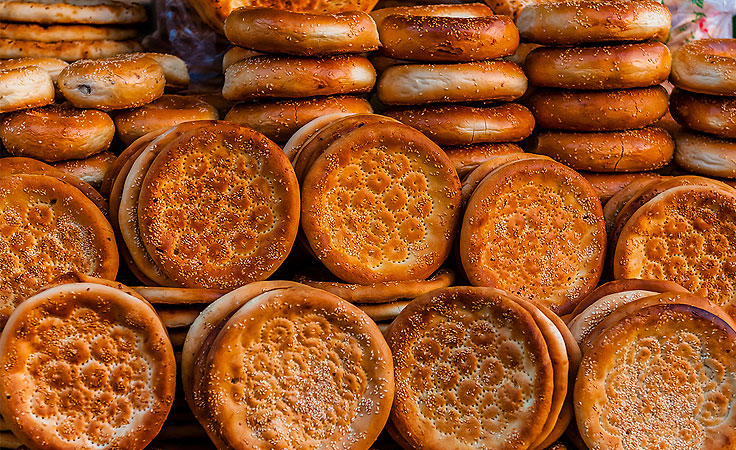
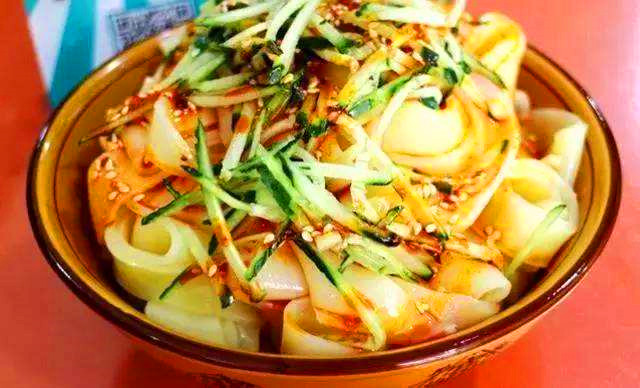
Cold noodle
Another popular Xinjiang snack is “Cold noodle”, “liangpi” in mandarin.It is different fromthe“liangfen"and “mianpi”from central China.“Liangpi”is madeout of steamed flour.It is chewier than “liangfen”and looksmore transparent than“mianpi”.It’s served with a kind of specialsauce and tastes simply appetizing.
Dairy
Dairy accounts for a great part of Xinjiang cuisine.Milk is in nearlyall kinds of Xinjiang drinks and desserts,such as pure milk,milk tea,milk wine, yogurt, cheese,“naipi”(milk skin),“naigeda”(dried milk)and butter.Horse milk and camel milk are also drinks of Xinjiang.
It may also be an unforgettable moment when you first drinkgenuine milk tea,eat fresh horse meat and seasoned sausages,make atoast to your hospitable nomad hosts,and sing along with them in theiryurts on the grassland.As long as you’re not a peculiar eater,Xinjiang should be agastronomic paradise for you.
It may be a treat to your taste buds and your brain to sit undera grape tree in the oasis,chewing newly-baked Nan,smelling thetempting smoke from the barbecue,learning how to eat“Pilaf"with your fingers,and inquiring into how to cook the yummiestmutton.

